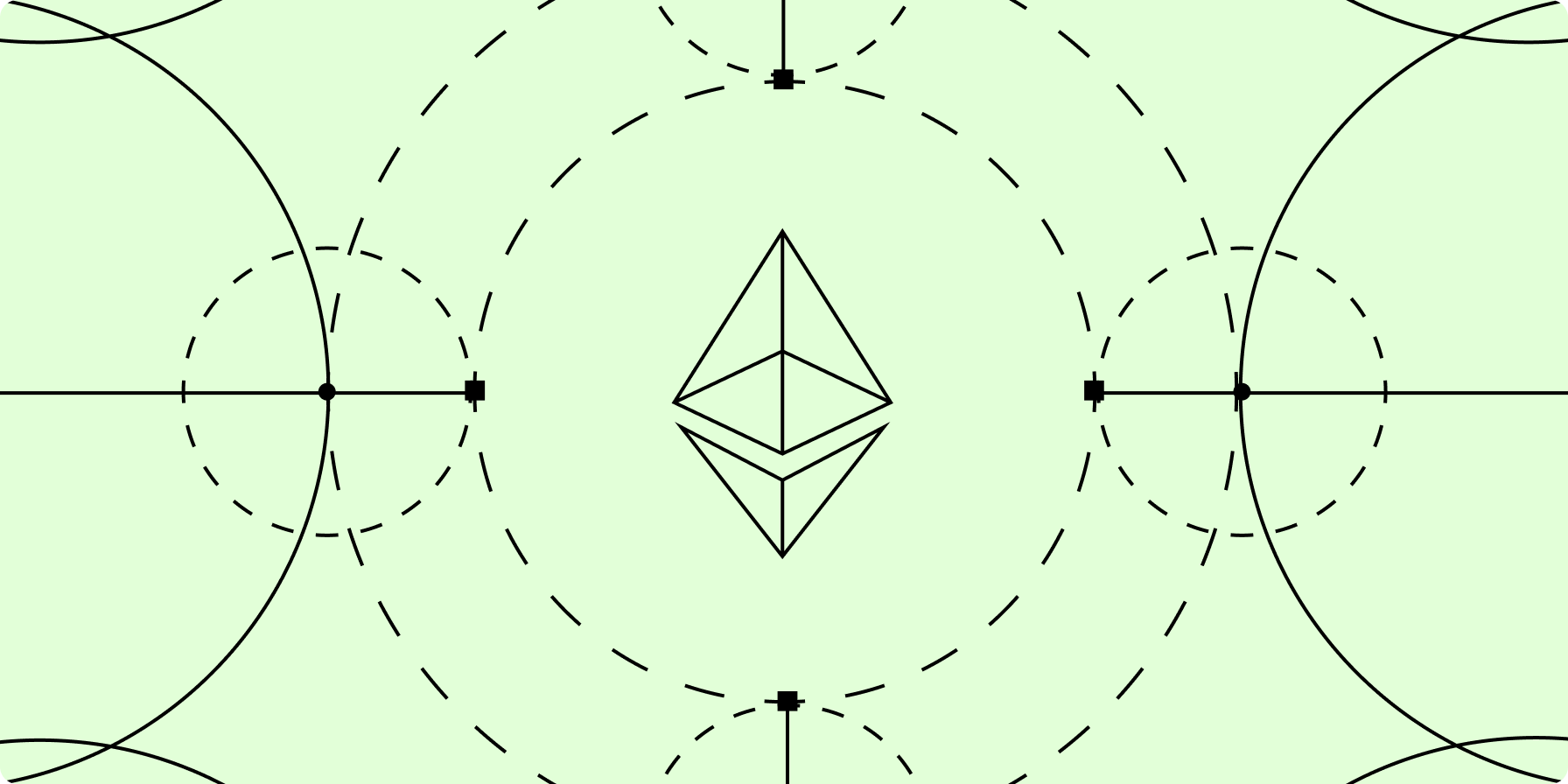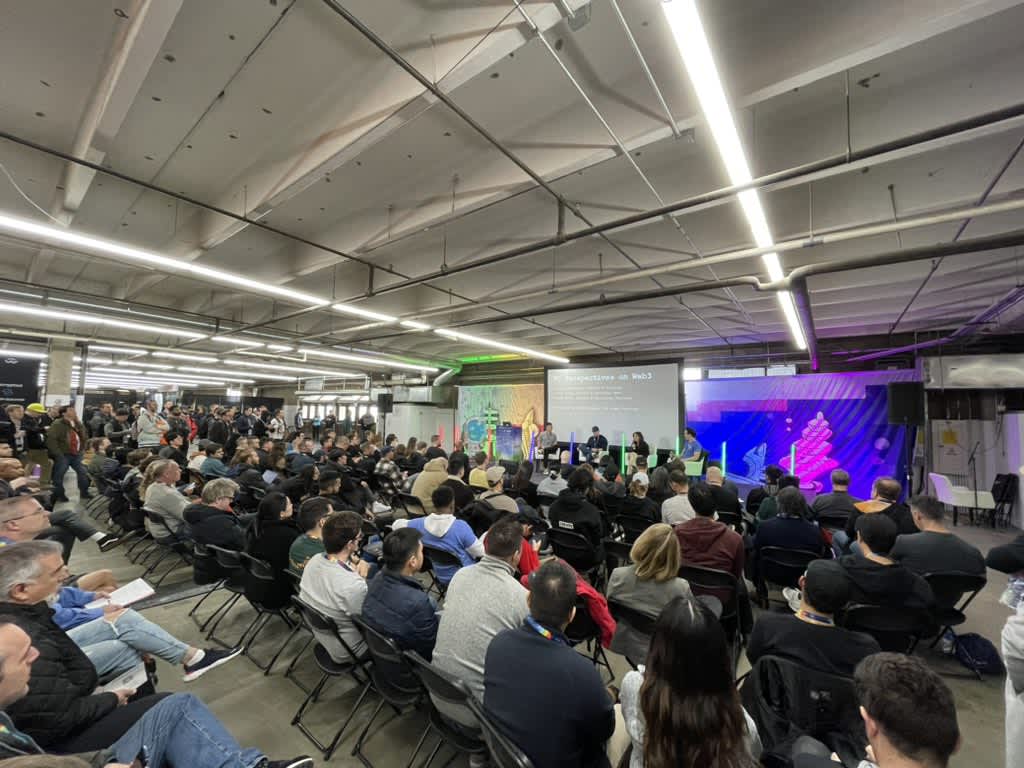Learnings from ETHDenver 2023: The World’s Most Sprawling Blockchain

Summary
Galaxy Research’s Christine Kim attends ETHDenver, the world’s largest and longest-running Ethereum conference, which was held at Denver’s National Western Complex last week. In this note, Christine explains the breadth of programming at the conference this year and what it conveys about the state of Ethereum development.
Back and Bigger Than Ever
The 6th annual ETHDenver conference was a massive event, attracting more than 20,000 attendees from around the world for a 10-day celebration of Ethereum and the network’s many diverse facets of development. The conference quite simply had it all: hackathons, fireside chats, panel discussions, solo presentations, coding workshops, numerous side events, free childcare, an NFT art gallery, and even a “zen zone” for decompressing and sleeping during off-hours of the conference all in one giant venue.
Last year’s ETHDenver conference was held at the Sports Castle, which is a four-story, 35,000 square feet building originally used as a Chrysler car showroom. This year, ETHDenver was held at the National Western Complex, which is a sprawling, 48,000 square feet multipurpose venue normally used for rodeos, livestock competitions, and horse shows. Last year, ETHDenver attracted roughly 15,000 attendees, whereas this year the conference grew to accommodate its largest turnout of attendees yet and for every participant, the conference organizers had something to offer. Every square foot of the gigantic venue was completely filled with an activity, booth, or stage. These activities were grouped together geographically at National Western Complex by track. The five main tracks included: DAOs + Community, Decentralized Finance, Public Goods, Infrastructure, NFTs + Metaverse + Gaming.

The breadth of topics covered by the programming at ETHDenver this year was impressive. Still more impressive was the fact there were a plethora of side events to ETHDenver hosted by other entities throughout the city diving deeper into topics like MEV, shared security, ZK tech, account abstraction, TEEs, privacy, and more despite the wide coverage and ample space organized through the main conference. The chaotic energy created by all different types of Ethereum developers and community builders gathering in one city also helped fuel a sense of continued optimism and excitement for the future of Ethereum regardless of current market dynamics or ETH price. For a short, 10-day period, the focus of everyone’s minds at the conference was on preparing and building for the next wave of user adoption.

A Sight to Behold
But digging beyond the surface-level conversations around DAOs, DeFi, blockchain infrastructure, NFTs and other buzzworthy topics at the conference, it’s clear that the main narratives around development on Ethereum haven’t changed all that much since Devcon VI hosted back in October 2022. There remains a lack of innovation for application development on Ethereum. Most innovation is happening in the infrastructure that supports applications, such as rollups and blockchain design, but new, game-changing applications are hard to come by. Within the infrastructure space, most of the innovation continues to face the same issues of a lack of decentralization and censorship resistance that have characterized blockchain scaling techniques for years, and there hasn’t been much advancement on solving them yet. Concerns around centralization to and the overreliance on trusted entities to mitigate the negative impacts of MEV remain a source of concern for the Flashbots team and Ethereum core developers. Beyond the veneer of excitement around how much is happening on Ethereum, there was little about the projects or discussions at ETHDenver that presented new narratives or ideas about the future of Ethereum development.
Rather than present new ideas, the discussions at ETHDenver reaffirmed that incremental progress is being made on existing priorities. This year, the focus of Ethereum core developers remain on activating staked ETH withdrawals through the Shanghai upgrade and the early steps of proto-danksharding through the Cancun upgrade in the Fall. The Flashbots team continues to make progress towards realizing its vision of decentralized block building through hardware-based memory encryption. Other teams like Obol, SSV, and Diva are making headway in advancing distributed validator technology (DVT) for implementation on Ethereum, which would help improve the distribution of the validator set across multiple entities and staking pools. Staking pools like Rocketpool are focusing on improving their scalability through reducing costs for validator node operators and opening new staking services for institutions. Layer-2 rollup teams such as Arbitrum, Optimism, Polygon, Scroll, and zkSync continue to perfect their technology for greater speeds, lower costs, and stronger security guarantees.
Walking around the conference hall at ETHDenver this year, I was reminded of how much development on Ethereum occurs outside of Ethereum core protocol development. Ethereum is like a sprawling city where, beyond the confines of the protocol, there is an unrestricted and limitless amount of experimentation occurring on top of the codebase, even as the codebase continues to evolve. Regardless of the speed at which core developers work, Ethereum today is already supporting permissionless innovation at a large scale among decentralized application developers, blockchain infrastructure providers, and academic researchers and cryptographers, so much so that it is becoming impossible to define a single, cohesive narrative around the state of Ethereum development. Rather there are several compelling narratives around Ethereum development, each of which is actively in the process of being tested by a different group of developers and builders. While there weren’t any significant advancements in these narratives at ETHDenver, there was a clear illustration of them all thriving under one roof at the conference, which my, was a sight to behold.
Legal Disclosure:
This document, and the information contained herein, has been provided to you by Galaxy Digital Holdings LP and its affiliates (“Galaxy Digital”) solely for informational purposes. This document may not be reproduced or redistributed in whole or in part, in any format, without the express written approval of Galaxy Digital. Neither the information, nor any opinion contained in this document, constitutes an offer to buy or sell, or a solicitation of an offer to buy or sell, any advisory services, securities, futures, options or other financial instruments or to participate in any advisory services or trading strategy. Nothing contained in this document constitutes investment, legal or tax advice or is an endorsementof any of the digital assets or companies mentioned herein. You should make your own investigations and evaluations of the information herein. Any decisions based on information contained in this document are the sole responsibility of the reader. Certain statements in this document reflect Galaxy Digital’s views, estimates, opinions or predictions (which may be based on proprietary models and assumptions, including, in particular, Galaxy Digital’s views on the current and future market for certain digital assets), and there is no guarantee that these views, estimates, opinions or predictions are currently accurate or that they will be ultimately realized. To the extent these assumptions or models are not correct or circumstances change, the actual performance may vary substantially from, and be less than, the estimates included herein. None of Galaxy Digital nor any of its affiliates, shareholders, partners, members, directors, officers, management, employees or representatives makes any representation or warranty, express or implied, as to the accuracy or completeness of any of the information or any other information (whether communicated in written or oral form) transmitted or made available to you. Each of the aforementioned parties expressly disclaims any and all liability relating to or resulting from the use of this information. Certain information contained herein (including financial information) has been obtained from published and non-published sources. Such information has not been independently verified by Galaxy Digital and, Galaxy Digital, does not assume responsibility for the accuracy of such information. Affiliates of Galaxy Digital may have owned or may own investments in some of the digital assets and protocols discussed in this document. Except where otherwise indicated, the information in this document is based on matters as they exist as of the date of preparation and not as of any future date, and will not be updated or otherwise revised to reflect information that subsequently becomes available, or circumstances existing or changes occurring after the date hereof. This document provides links to other Websites that we think might be of interest to you. Please note that when you click on one of these links, you may be moving to a provider’s website that is not associated with Galaxy Digital. These linked sites and their providers are not controlled by us, and we are not responsible for the contents or the proper operation of any linked site. The inclusion of any link does not imply our endorsement or our adoption of the statements therein. We encourage you to read the terms of use and privacy statements of these linked sites as their policies may differ from ours. The foregoing does not constitute a “research report” as defined by FINRA Rule 2241 or a “debt research report” as defined by FINRA Rule 2242 and was not prepared by Galaxy Digital Partners LLC. For all inquiries, please email [email protected]. ©Copyright Galaxy Digital Holdings LP 2022. All rights reserved.



